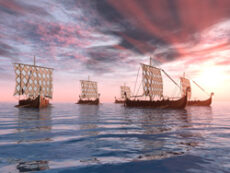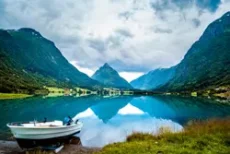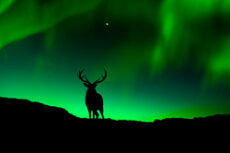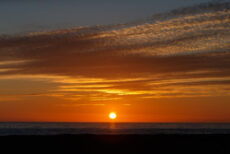NordfjordeNorway from Vikings to Fjords to the Midnight Sun and Northern Lights
 In northern Europe, the thinly populated Kingdom of Norway, whose dominion includes the Arctic islands of Svalbard and Jan Mayen, is partitioned by mountains and has a fjord-gashed shoreline that exceeds 21,000 kilometers. Ever since Vikings left home waters in the ninth century, Norway has drawn strength from the sea.
In northern Europe, the thinly populated Kingdom of Norway, whose dominion includes the Arctic islands of Svalbard and Jan Mayen, is partitioned by mountains and has a fjord-gashed shoreline that exceeds 21,000 kilometers. Ever since Vikings left home waters in the ninth century, Norway has drawn strength from the sea.
The Viking kingdoms
The Viking kingdoms of Norway were unified in 872 AD by Harald Fairhair. In the following period, Norwegians settled in many places, such as Iceland, the Faroe Islands and parts of Scotland and Ireland, where they founded Dublin. In the beginning of the 14th century, Norway and Sweden were unified as the Norwegian king was also elected king of Sweden. At the end of the century, the two countries and Denmark were unified in the so-called Kalmar Union.
Explore Norway
There is a wonderfully exhilarating feeling of space wherever you go in Norway. This vast and beautiful country has a population of just 4.8 million, which equates to around 12 people per square kilometre, so when exploring the countryside you can often feel like you have it all to yourself.
Hunt for mesmerising aurora in Tromso, cruise to the North Cape on a coastal voyage, explore the mighty Sognefjord on a summer self-drive or ride the Flam Corkscrew railway. From historic Oslo, to atmospheric Bergen to the enchanting Lofoten Islands, whatever your interests we offer a range of itineraries that showcase the best of Norway taking in the most well-known sights as well as some hidden gems.
Norway is known for nature attractions like fjords, mountains and midnight sun, and is easily accessible by plane from most European countries.
Vikings
 The Vikings, natives of present day Denmark, Norway and Sweden, burst onto the world stage and into history between the 8th and the 11th centuries. January 8th, 793 marks the first recorded account of the Vikings when they raided and destroyed the Christian monastery on the small island of Lindisfarne, Northumbria, England. The Vikings have a bad reputation as raiders, but they were also traders, explorers and settlers, and the legacy from the Viking Age (AD 800-1050) lives on.
The Vikings, natives of present day Denmark, Norway and Sweden, burst onto the world stage and into history between the 8th and the 11th centuries. January 8th, 793 marks the first recorded account of the Vikings when they raided and destroyed the Christian monastery on the small island of Lindisfarne, Northumbria, England. The Vikings have a bad reputation as raiders, but they were also traders, explorers and settlers, and the legacy from the Viking Age (AD 800-1050) lives on.
The Sami people
 The Sami are the indigenous people of Norway. Known for their colourful clothes and the huge herds of reindeer they look after, the Sami have been living in northern Scandinavia for over 10,000 years, and today they have their own parliament in Karasjok. Sami people live nowadays in an area which spreads from Jämtlands Län in Sweden through Northern Norway and Finland to the Kola Peninsula in Russia. There are some 100,000 Sami living here, about half of them in Norway.
The Sami are the indigenous people of Norway. Known for their colourful clothes and the huge herds of reindeer they look after, the Sami have been living in northern Scandinavia for over 10,000 years, and today they have their own parliament in Karasjok. Sami people live nowadays in an area which spreads from Jämtlands Län in Sweden through Northern Norway and Finland to the Kola Peninsula in Russia. There are some 100,000 Sami living here, about half of them in Norway.
Norwegian Fjords
 Fjords are found in locations where current or past glaciation extended below current sea level. A fjord is formed when a glacier retreats, after carving its typical U-shaped valley, and the sea fills the resulting valley floor. Norway is famous for its fjords, they are unquestionably what the country is most famous for, and the primary motivator for many travelers to visit, two of which, the Geirangerfjord and the Nærøyfjord, feature on the UNESCO World Heritage list. The Sognefjord, the longest of them all, and the Hardangerfjord, famed for its cherry and apple trees, are among the most visited.
Fjords are found in locations where current or past glaciation extended below current sea level. A fjord is formed when a glacier retreats, after carving its typical U-shaped valley, and the sea fills the resulting valley floor. Norway is famous for its fjords, they are unquestionably what the country is most famous for, and the primary motivator for many travelers to visit, two of which, the Geirangerfjord and the Nærøyfjord, feature on the UNESCO World Heritage list. The Sognefjord, the longest of them all, and the Hardangerfjord, famed for its cherry and apple trees, are among the most visited.
Northern lights (Aurora Borealis)
 The northern lights are a common natural phenomenon in Northern Norway, and are most commonly observed above the Arctic Circle between late autumn and early spring. The northern lights are a physical phenomenon that occurs when electrically charged particles from the sun hurtle towards the Earth. The light becomes visible when the particles collide with gases in the Earth’s atmosphere. The Earth’s magnetic field directs the particles towards the openings near the North and South Poles, and thus the phenomenon can only be observed near the magnetic poles. The polar light in the northern hemisphere is called aurora borealis – or northern lights – while the polar lights in the southern hemisphere are called aurora australis, the southern lights.
The northern lights are a common natural phenomenon in Northern Norway, and are most commonly observed above the Arctic Circle between late autumn and early spring. The northern lights are a physical phenomenon that occurs when electrically charged particles from the sun hurtle towards the Earth. The light becomes visible when the particles collide with gases in the Earth’s atmosphere. The Earth’s magnetic field directs the particles towards the openings near the North and South Poles, and thus the phenomenon can only be observed near the magnetic poles. The polar light in the northern hemisphere is called aurora borealis – or northern lights – while the polar lights in the southern hemisphere are called aurora australis, the southern lights.
Norwegian Midnight sun
 Norway is known as the land of the midnight sun, because certain areas of the country get 24 hours of sunlight for part of the summer. Visitors can experience festivals and cruises dedicated to the all-night light. The sun does not set in summer over the Arctic Circle, meaning visitors to Northern Norway enjoy 24 hours of daylight this time of year. It’s quite the challenge to suppose that there’s a place blessed by the sun all day and night long. To believe that there’s a time when the vibrant hues of dusk might refuse to succumb to the glittering darkness, instead choosing to reinvent themselves as sunrise. North of the fabled Arctic Circle, the Norwegian island of Mageroya is one such place, and summer here is one such time. Standing on the island’s North Cape at midnight in a haze of light, it all makes perfect, beautiful sense.
Norway is known as the land of the midnight sun, because certain areas of the country get 24 hours of sunlight for part of the summer. Visitors can experience festivals and cruises dedicated to the all-night light. The sun does not set in summer over the Arctic Circle, meaning visitors to Northern Norway enjoy 24 hours of daylight this time of year. It’s quite the challenge to suppose that there’s a place blessed by the sun all day and night long. To believe that there’s a time when the vibrant hues of dusk might refuse to succumb to the glittering darkness, instead choosing to reinvent themselves as sunrise. North of the fabled Arctic Circle, the Norwegian island of Mageroya is one such place, and summer here is one such time. Standing on the island’s North Cape at midnight in a haze of light, it all makes perfect, beautiful sense.